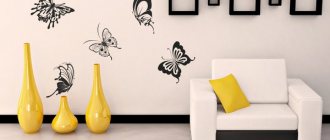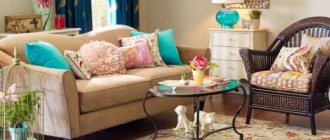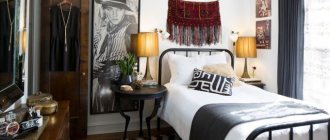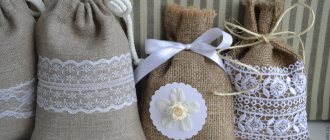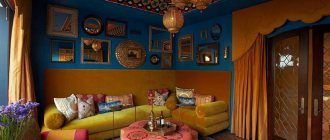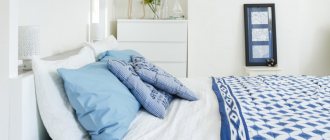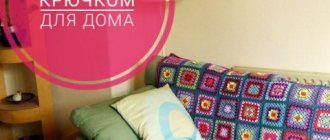Sewing pillows with your own hands means not only saving on bedding, but also decorating your interior, giving it individuality using simple and inexpensive means. Looking at photos of homemade pillows on the Internet, it may seem that this requires a lot of experience or innate talent. But the same problems can be solved much more simply, and certainly, when sewing pillows, it is possible to go from simple to complex, ultimately creating things worthy of prizes at amateur art exhibitions. This article is intended to help readers overcome several stages of this path.
What you need to know right away
It is not always possible to sew original pillows as simple sleeping pillows, in the form of a base and a pillowcase. Therefore, special attention should be paid to the choice of fabric and padding. The pillow is conducive to sleep, and someday someone will fall asleep on it. Probably tired, with unwashed and unkempt hair: when your eyes are stuck together, there is no time to look at beauty, it would be a good place to lay your head. That is, the covering fabric should not only accept finishing well, but also be cleanable. And the best thing is that the stuffing can be removed and the cover washed without spoiling its decor. In addition, the filling itself should maintain hygienic qualities, elasticity and be moderately pliable for as long as possible. We will return to materials for pillows that meet these requirements, but for now we will discuss ways to decorate them from simple to complex, keeping in mind the above.
Colors
It is better to choose the shades of the material based on the interior of your apartment. However, you can, on the contrary, make some contrast to add a little color.
Note!
Kinusaiga technique for beginners: what is it, a description of creating paintings from threads
How to weave a figurine from rubber bands: how to learn to weave animals, toys and what you can make from rubber bands on a slingshot
How to make flowers with your own hands from paper, fabric and scrap materials. We create bouquets of homemade artificial flowers
Methods for decorating pillows
Colors
The easiest way to sew decorative pillows in the same way as regular sleeping pillows is to choose the color of the fabric. And the simplest of the simplest solutions is several pillows of different colors, forming an ensemble that fits into the interior. In this way, you can not only turn a cocotte’s boudoir into something like a soft fluffy cloud, but also express the individuality of laconic interior styles. This kind of work, I must say, is mentally very difficult, but technologically and financially elementary. For example, on the left in Fig. It’s no wonder that a sofa with a composition of pillows is placed against the backdrop of a window (painting?) with living greenery contrasting with the overall tone, and a flower in a vase is placed to the right of the sofa.
The role of fabric colors in the decor of pillows
In the center in Fig. a method based on similar aesthetic principles, but not requiring a laconic interior and special organization of the placement of its objects. The point here is that the background of the furniture upholstery and the cushion cover is the same, as is the tone and density of the pattern in both, but the designs of the patterns are slightly different. And the pillow is highlighted wide, the so-called. French, edging, the same as the general background, but of a darker color; The color is slightly lighter on the lower and side parts of the furniture upholstery.
Finally, on the right in Fig. shows a way to give a pillow, by choosing the color of the fabric, what is said to be aesthetic self-sufficiency, i.e. the ability to express the meaning inherent in it by the craftswoman in any environment. Imagine such a pillow in... a garbage dump. Will she look worse there? And the point here is not only and not so much in the choice of 2-3, no more, catchy colors that make up a fairly large pattern, but also in the arrangement of stylized images of flowers on the visible surface of the thing.
Applications and printing
Decorating pillows with appliqués can be just a little more technically difficult, but no less expressive. Here, as before. In this case, the key to success is the artistic taste of the author and, preferably, the combination of at least 2 things into an ensemble, and, unlike the use of colors, its meaning can be absolutely clear to the point of frivolity, as on the left in the row of photos, but obscenity is morally healthy a person will see in this composition no more than in a normal marital relationship.
Decorating pillows with applique and fabric printing
An expanded multi-valued composition of pillows with appliqués is technically more difficult to execute, and there is a risk of running into flickering. However, these days, photo printing on fabric is affordable, and the images are durable and of the same quality that the texture of the material allows. So, when considering a multi-pillow group with pictures, first of all it is worth considering the option of photo printing on blanks, in the center in the figure, especially since you can select/create pictures and model the entire ensemble in advance on a computer.
Note: modern technology of photo printing on fabric allows you to create images that are visually equivalent to embroidery. Flaps with printed pictures can also form the basis of an applique, on the right in Fig.
Form and fragment
Most good designers prefer to work with form, considering it the root cause of the expressiveness of things, and color, texture and pattern/pattern as factors of the next orders of magnitude. One-, two-, or three-tone sofa cushions, the aesthetic value of which is achieved by the form, can also be technologically simple (item 1 in the figure) thanks to the use of modern materials, see below.
The role of shape in the decor of pillows
Working with form, it becomes possible to apply a new approach to meaningful decoration of a thing: modularity, poses. 2. Technologically, in this case, labor intensity only monotonically increases without the emergence of fundamental difficulties, because All modules assembled into the product are structurally similar and simple. But in such cases, you need to think about how to clean it, unless you want to completely redo it at least once every 1-2 years. A furniture vacuum cleaner and cleaning products for it are understandable, but it is necessary to use them less often.
The modular principle also allows, without a significant increase in labor intensity, to create sewn items of simple shape, in which the form nevertheless works for aesthetics. This is the so-called. patchwork technique; simply patchwork. Patchwork is not necessarily something deliberately rough, rough, or even tacky.
Decorative pillows using the patchwork technique can be sewn gracefully and neatly without agonizing thoughts and looking at samples/sketches until it hurts your eyes, poses. 3 and 4. You only need a key element (mainly in the center), which is in harmony with the overall design of the thing, but also stands out in some way. At pos. 3 this is achieved by a pattern of the same tone, but much larger than that of the elements of one diagonal and at the same time, naturally, smaller than the solid color filling of the squares of the other. And at pos. The 4th key, on the contrary, is distinguished by its shape, small size and relief (convexity).
Key element
In general, a compact key element(s) can add elegance to a pillow made in any technique. For example, at pos. 1 pic., the key is a simple button combined with a turn of scraps of fabric with a trivial black and white geometric pattern, right down to scraps of an old mattress. If using a brighter, more colorful material instead of a fabric-covered button, a button with a round gathered bow, pos. 4.
Key elements in pillow decor
At pos. 2 tassels and a button elevate pillows made of modestly colored fabric. This approach is attractive because it is possible to use furniture upholstery and even technical fabrics that do not get dirty easily, are easy to clean, but are not bright and shiny. And at pos. 3 is an example of how brushes add aesthetic value to a pillow with a pattern that is too small for this purpose. Perhaps the larger pattern somehow didn’t fit into the overall design, but the pillow still needed decorative self-sufficiency, so the brushes came to the rescue.
Note: a single brush on the corner of the pillow can play a purely utilitarian role, without losing its aesthetic value, by hiding the last seam, see below. In this case, it can be successfully replaced with a pompom. How to make a brush and pompom with your own hands, see next. Fig., but in general, you need to be careful with tassels and pom-poms as numerous elements of the main decoration of pillows, see below.
How to make a brush and pompom at home
Lace, knitting and embroidery
All these methods of decorating pillows (see fig.) have in common that things, on the one hand, are labor-intensive and difficult to perform (unless ready-made lace or organdy is used). On the other hand, lace and knitted cushions for the sofa provide not only a magnificent aesthetic effect, but also respect and prestige: complex, high-quality work speaks for itself. Moreover, all such things are cleaned and washed many times: people have been weaving lace and knitting for centuries; Both skills are quite adapted to washing much more harshly than in a modern washing machine with synthetic detergents.
Lace and knitted pillows
Knitted sofa cushions have another advantage: they mask the last seam without any difficulty, see below. And, by the way, thanks to this same circumstance, knitted decorative pillows can be very simple to make if you sew them from old sweaters, as on the right in Fig.
About knitwear
Decorative pillow from an old children's sweater
Knitwear as a material for covering a pillow retains all the advantages of knitted items, incl. the ability to conduct a hidden facial seam. It also has its own special advantages. Firstly, the softness of the surface - wool sometimes “bites” the face, and knitting from mohair or down is more difficult. Secondly, accessibility: who hasn’t had to wonder what to do with the sweaters and blouses of a grown child? Stuff it with holofiber (see below), sew up the armholes, embellish it a little - and in an hour and a half a good original pillow is ready from scrap materials, see fig. Whether it will fit in the living room is a matter of overall design, but as a pillow for a nursery it will be quite in its place. You can also sleep on it without risking button marks on your cheek: you turn it over, and that’s it.
About embroidery on pillows
For those who know how to embroider, a pillow is a beneficial canvas in all respects, see figure:
Embroidered decorative pillows
If you want to embroider across the entire field, you will need a special frame-shaped hoop; the canvas in it is stretched (unfolded) with harsh threads. Drawing, pattern - everything here is at your discretion and skill, but there are some features compared to embroidery of other things:
- There is no need to embroider with beads, it will be unhygienic and inconvenient. It is impossible to completely remove dirt particles from the holes in the beads using any known methods of cleaning pillows, and lying down on the beaded surface is also not very pleasant;
- Cross stitch: satin stitch embroidery under the head/body quickly gets dirty and slips, and wrinkles when washed;
- When embroidering across the entire field, make a continuous wide edging: it is just as easy to hide the last seam in it as in a knitted pillow.
Relief
Relief decor: fringe, bows, frills, puffs, intarsia, weaving, voluminous appliqués (stripes), quilting, etc., etc., see fig. – widely used for finishing pillows, because allows you to achieve stunning aesthetic effects. However, when starting your first (or next) masterpiece, keep in mind, firstly, that creating beauty using the “I want a lot of everything!” And more!”, is wrong in principle. You need to understand what you feel, what you want, and express it through the means available to you. Which do not necessarily have to be sophisticated and intricate.
Decorating pillows with volumetric elements
Secondly, remember - you are not the trusted seamstress of the Marquise of Pompadour or the Countess deMoncero. The beauty you created with your own hands is unspeakable and you have to wash it once. And the point is not only whether this thing can withstand washing, but also whether the machine can withstand washing such a thing. Otherwise, the hour is uneven, you will have to master interesting, but by no means simple, methods of repairing washing machines. The fringe with tassels can still be torn off and sewn on again, but for a stained, labor-intensive pom-pom pillow, it’s hard to think of anything better than throwing it away and making a new one. If you have enough spirit for it after such an opportunity.
Simple ways to make fabric roses
However, dissuading people from striving for beauty is pointless, and even unbecoming. So about every case in Fig. Above are 2 ways to make roses from felt or cotton pads. If necessary, such flowers can be easily removed and then sewn on again. Or simply make new ones to replace worn ones.
Decorating a pillow with simple bows
And in Fig. on the right - advice about bows: take as a basis the same principle of laconicism, it will never let you down, and make simple bows so that you can untie and tie them for caring for the pillow. That pillow is made of burlap, but does it look good?
How to make a decorative pillow with your own hands
You can spend days searching for the perfect pillow for your home and still not find the right one. But hand-made sofa models will definitely delight you and your guests. Whether it is a single-color pillow or a combination of different fabrics and shades, it will fit perfectly into the interior and emphasize the individuality and uniform image unique to your home.
Handicraft is always an experiment, but with the help of various master classes and expert advice you can avoid ridiculous mistakes.
There are several ways to make a beautiful decorative pillow with your own hands:
- Hand-painted old pillowcases (painting fabric using specialized means or using non-standard technologies).
- Sewing pillows from various pieces of fabric and decorating products with appliqués.
- Knitted pillows using knitting needles or crochet (do not require special skills and abilities, so they are ideal for beginning craftswomen).
- Decorating purchased products of basic models (buttons, embroidery, ribbons, adding ready-made textiles with felt elements).
Next, we will look at each of these options in more detail and provide simple master classes that even a child can do. To create decor for a children's room, you can use the brightest colors and unusual shapes. We recommend choosing materials together with your child and entrusting him with part of the work on making the pillow.
Painted pillow
You can transform textiles quickly and inexpensively using cold water or ice. Painting old pillowcases has long been popular, but previously special chemicals were used for this purpose. Now a new technique of painting with ice has appeared, and it baffles many people with its originality. However, in the end, you are guaranteed stylish and unusual decor - you can see an example in the photo below.
Related article: Beautiful Easter baskets made of paper and cardboard (3 MK)
To recreate something like this you will need:
- white fabric (you can use a cotton or linen pillowcase);
- metal oven rack;
- a container of suitable size (so that the grill fits into it);
- several ice cubes depending on the size of the canvas;
- latex gloves.
First of all, you need to wet the cloth well and place it on a wire rack pre-installed above the sink. Place the canvas with the front side on the grid - to do this, you need to crumple it slightly so that the pattern turns out to be more unusual due to the heterogeneity of color. Next, ice is laid on top of the fabric and sprinkled with powder and dye added.
At this point, all the work is finished, all that remains is to wait until the ice melts and send the pillowcase to dry. Before doing this, it is recommended to dip it in cold water several times.
In the video: 4 ways to decorate pillows using the tie die technique.
Knitted option
A decorative pillow, knitted or crocheted, is the simplest product that can be knitted. For beginner craftswomen, medium-sized knitting needles connected to each other are best suited. The type of yarn does not really matter; the only thing you should stick to when choosing is the thickness of the threads. If you are going to combine several shades, then it would be wiser to choose a material of the same thickness.
Knitted pillows always look beautiful and elegant. They can decorate any interior of a living room, bedroom or dining room.
Don't be upset if the first time you don't succeed in completely following the knitting pattern. Sloppy parts can be disguised by sewing voluminous flowers. You can buy them at the store or make them yourself. To begin with, try the simplest options possible - most often these are products made from ordinary air loops with several double crochets. Below is a pattern for knitting a decorative pillow for beginners and the finished result.
In the video: knitted decorative pillows made from large squares.
Patchwork style
The patchwork technique involves the use of different types of fabrics with different textures and shades. This style is great for creating cute items for the home, such as napkins for table decorations, a sofa cushion, or a baby blanket.
Next we will look at how to sew a decorative pillow:
1. Choose a fabric of a suitable color (it is advisable that the individual pieces match each other). Take the fabric and cut out nine equal-sized squares and five hearts.
2. From the five resulting squares, cut a small hole in the shape of a heart. Cut the four elements diagonally so that you get four triangles. Plan the layout of the future product, as shown in the photo below.
3. Sew together four elements that are assembled into one square. Repeat with other scraps of fabric. Then sew the hearts into the squares and stitch together all the finished parts, arranging them three by three.
4. Cut out four thin strips and the same number of squares. Connect all the elements together. Finally, take a single piece of fabric (its size should match the front of the pillow) and sew in a snake. Sew together the front and back parts and fill the resulting gap with padding polyester or holofiber.
Related article: Do-it-yourself original lamps from various bottles (3 MK)
Fluffy pillow
Fluffy textiles are presented in a wide range of stores, but their price leaves much to be desired. This original pillow will look spectacular in any interior. If it is made of fleece, it will certainly become a favorite thing in the children's room. Making a fluffy pillow is very simple, you just need a little patience, the ability to sew and work with patterns.
The finished product will bring coziness and comfort to your home and will delight guests on cold winter evenings near the fireplace.
The required materials and tools include:
- fleece for making the base and fringe;
- filler (most often synthetic winterizer is used);
- scissors and thread;
- corners of different sizes (pins are also needed);
- sewing machine.
Operating procedure:
1. First of all, you need to cut out two squares of 40 by 40 centimeters from fabric for the base of the product.
2. To create fringe, we recommend using fleece in different shades to achieve a beautiful transition. We make ten strips 37 by 10 centimeters, then fold them in half and make a fringe.
3. Sew the first element to the base, stepping back one centimeter from the edge (don’t forget to bend the fringe to one side).
4. Sew the second strip at a distance of 1.5 centimeters from the first. Perform this operation around the perimeter of the entire product.
5. After the fringe blank is made, place a second square on top of it and pin it together. Sew the resulting pieces together, leaving a small hole for the filling.
6. Turn the fabric inside out and put the padding polyester inside. Please note that it is better not to use natural materials as filler (cotton wool and fluff).
Flower pillow
Decorative pillows can be of any shape and size. In this case, we are creating a product in the shape of a flower. To do this, you will need ten scraps of fabric (five plain and five with patterns).
Progress:
1. Connect all the elements together and cut out small but neat petals. Then you need to sew them in pairs, connecting the plain part with the patterned one. It is important to leave a small hole for the filler.
2. After the petals are ready, straighten the bottom of the scraps and baste the fabric (stepping back one centimeter from the edge).
3. Sew all five petals to the base. Place stuffing in the middle of each and sew the edge together.
4. Insert each finished circle into a flower and sew them to the petals. So we have a pillow in the shape of a flower. With its help, you can decorate a girl’s nursery or living room in neutral shades.
It’s not difficult to create comfortable, stylish pillows with your own hands. Nowadays there are a huge number of ideas for handicrafts on the Internet, you can easily choose the option that suits you. However, do not forget about the theme and style of the interior and take a responsible approach to the choice of materials. To ensure that beauty and family well-being always live in your home, do not neglect the original decor. Leave comments so other visitors can benefit from your tips.
Well, very original pillow options (3 videos)
Ideas for inspiration (58 photos)
About buffs
Puffs on a suitable fabric, smooth and glossy, are another matter. When done correctly, they can be vacuumed and hand washed without any problems. And making all this splendor is not as difficult as it seems. First you need to learn how to read the diagrams for assembling puffs (assembling them, as sewing makers say).
As an example, diagrams for assembling simple puffs are shown in Fig. below. All puff patterns are built on an orthogonal-diagonal grid, the module of which (the side of the square) is 2-7 cm, depending on the size of the product and the density of the fabric. The grid in the diagram can be shown explicitly, as on the right in the figure, or its nodes can only be marked with dots, as on the left. The mesh is applied to the back of the workpiece with a textile marker in a mirror image.
Further, areas that are contracted (collected, assembled) into a buffer are marked either with converging arrows (on the left) or red lines (on the right), and those that are not contracted are marked with simple thin lines. The puffs can be assembled either with one thread or separately. The first method is for the lazy, because... a web of threads is formed from the inside. In any case, each puff is assembled with at least 3 stitches 4-5 mm wide, unless otherwise indicated in the notes to the pattern.
Examples of puff patterns for pillows
Then, the assembly sequence. It is produced in horizontal or vertical rows, again, unless otherwise indicated in the description of the pattern. In the case where the rows are indicated explicitly (on the left), they are displayed in numbering order and the buffs in the row are also assembled by numbers; here – Row 1 1-2, 3-4, etc., then Row 2 and so on. In the absence of an explicit indication of the rows (on the right), the puffs are assembled simply in numerical order; according to the diagram on the right - 1-2, 3-4, 5-6, 7-8, etc.
Try to assemble any scrap of fabric into puffs according to these entry-level patterns, and you will see that it will take little time, even if you assemble one at a time. And then watching a selection of master classes on making pillows with puffs that are much more spectacular and complex won’t seem like a nightmare:
Video: DIY buffalo pillows, master classes
Pattern for a standard pillow
You can make a lot of standard thoughts at once, and then create original pillowcases and change them according to your mood.
It is very simple to sew a classic pillow for a medium-sized interior. To do this, you need a pattern, fabric, a sewing machine (you can do without it), a zipper, threads and needles.
Do not worry! To sew decorative pillows with your own hands, you don’t need to have any training as a seamstress, you just need time, desire and the ability to hold a thread and a needle.
The pattern for a classic square pillow with a lock is easy to make. It should be rectangular in shape, approximately 120+8 cm wide and 60+3 cm high. It is important not to forget to add the necessary centimeters in order to make a bend later. You need to use thick fabric that will serve as an internal cover. Buy a zipper that fits and sew it in with one line. Let's move on to the filler; padding polyester, holofiber or ordinary feathers are suitable here.
Related article: How to make a basket from a wicker with your own hands: the easiest way (MK)
When the base for the pillows is already available, all that remains is to sew the pillowcase and search for ideas for decorating it. Making pillowcases for pillows is simple: the pattern is the same as for the base, it is important that it fits in size.
About figurine pillows
The principle “You don’t need a lot of things! And simpler!” It is especially appropriate in relation to decorative pillows, which work aesthetically primarily through form. They are often sewn using patterns for soft toys, forgetting that a sewn cat does not know how to wash its own tail. And he will have to take on not only room dust, but also grease. Perhaps, especially when it comes to children's pillows, there are, so to speak, volley emissions of pollutants of biogenic origin.
In addition, they not only jump and ride on children's pillows; They not only fight and throw them around, they also sleep on them. And sleeping with your head askew, with your head slid to one side, is in no way beneficial to your developing skeleton. This especially needs to be taken into account when sewing a children's toy pillow; For example, we give the patterns in Fig.
Baby pillow patterns
On the left is a fish pillow. The shape and execution technique seem to have been chosen correctly: it is quite easy to care for, the last seam can be covered with a tail or fins. But the sleeper’s head may slide to one side, the shoulder will follow it and it will turn out that we are sleeping hunched over. The owl pillow, top right, is free from this drawback: the “ears” will hold. For those who toss and turn a lot in their sleep, it is better to place such a pillow with a deflection between the “ears” towards the neck; This pattern can easily be adapted for a cat pillow, only without the tail. In both versions, it is advisable to make the cut diagonal for better ergonomics as a sleeping accessory, see below.
Note: for children - irrepressible sleepy fidgeters, there is a pattern at the bottom right of a special pillow on which the child automatically learns to sleep on his back or side, stretched out freely.
Letter pillows
Pillows in the form of letters (see figure) have moved even closer from pillows to soft toys than pillows-figures: there are a lot of holes in them, where to sleep. It is believed that letter pillows are educational, developing, etc. Well, perhaps to coordinate movements and orientation in space, to climb between them large, like in a maze. As for the speedy learning of literacy, this has not yet been confirmed by science. However, no harm was noted from pillows in the form of letters, and the fun for the child is already a benefit for him.
Letter pillows
Large letter pillows must hold their shape well and withstand the appropriate operating conditions, in relation to which small users show amazing ingenuity. One of the design options of this kind is shown in Fig.:
Letter pillow filling pattern
Foam rubber 45 is furniture foam rubber of the highest density; We’ll talk about what holofiber is below. Of course, other methods of sewing letter pillows are also possible, see for example. next video.
Note: diagram in fig. It is also suitable for stuffing bolster pillows, if it is desirable to have their ends rounded.
Video: do-it-yourself letter pillows, manufacturing option
About puzzle pillows
Pillows in the form of elements of prefabricated Puzzle mosaic paintings are also quite popular. It is believed that, if necessary, they can be assembled into a mattress. It is possible to collect something, yes, then yes. But anyone who has tried to sleep on such a mattress knows: it is impossible, it is crawling under you. Pillows, unlike puzzle pieces, are soft and pliable, otherwise you’ll end up with some kind of bunks instead of pillows.
Materials and technology
We will not expand on the fact that when sewing you need to give cuffs of 20-30 mm, iron them, sew from the inside out and then turn the product inside out, etc., which is well known. In this section we will talk about things that are not always known to beginning seamstresses.
Textile
To properly sew a pillow without a pillowcase that is comfortable, hygienic, practical and durable, you need to choose the right fabric. Firstly, dirt particles should not stick to its fibers so that they can be sucked out with a vacuum cleaner without the use of detergents. Secondly, the covering fabric should, as far as possible, prevent dirt from migrating into the padding, which is difficult to clean and change. Silk, satin, crepe-satin and their synthetic analogues satisfy these conditions of light, smooth and bright textile materials. Light but soft - calico, flannel and other linen fabrics. Rough, but very durable - any furniture upholstery materials. Also, depending on the style of execution, it is possible to use any technical fabrics, except, perhaps, propylene matting and the like - too slippery, but at the same time rough and harsh.
Warp and weft
When cutting a pillow, the orientation of the warp and weft threads of the fabric matters. Orthogonal (straight) orientation, when the warp and weft are oriented perpendicularly (along) respectively. sides, allows you to more accurately maintain the shape of the pillow according to the pattern. But, if a straight-cut pillow with sharp corners is stuffed with sufficiently dense material, its corners may turn out to be empty and sag, pos. 1 in Fig.
The influence of the orientation of the warp and weft threads of fabric on the shape of the pillow
In pillows with a diagonal cut (the warp and weft are at 45 degrees to the sides), the corners will always be full, but a “waist” will appear that is larger than provided by the pattern, pos. 2. If the pillow is elongated, the thinnest “waist” will be on the long sides, pos. 3, which is not always desirable. In this case, the use of satin or twill weave fabric, pos. 4.
Padding
We won’t talk about cotton wool and clothing padding polyester for stuffing pillows: they cake and bunch up, only at different speeds. Natural bird down and feathers, due to their sanitary and hygienic properties, can serve for several generations: they have the ability to disinfect and neutralize dirt particles that have penetrated into the stuffing. Beetle eaters, lice eaters and chicken mites do not grow in stuffing from them - for the life of these parasites, a normal bird body temperature of 40-42 degrees is required; already at 38, the bird parasites die. Human harmful parasites also do not settle in bird feathers and down, except perhaps in the folds of the cover.
However, feather/down filling, firstly, is not elastic enough for decorative pillows; they are not fluffed like sleeping pillows, due to the rapid deterioration of the finish from such treatment. Secondly, small soft feathers and natural down for filling pillows are difficult to obtain. In the old days, the whole family collected feathers and down for years for the future bride for her wedding feather bed (an indispensable attribute of the dowry).
Nowadays, almost ideal stuffing materials for pillows have been developed - synthetic down and holofiber. In terms of hygiene, they are not inferior to swan's down; however, not for the lifetime of generations, but up to 7-10 years. On the other hand, the decor of the pillow no longer lives. But these materials have an undoubted advantage: they are moderately elastic and retain this quality for years.
Types of holofiber
In essence, synthetic down and holofiber are the same material based on the finest tangled polyester fibers; This is the same polyethylene terephthalate (PET) that food utensils and bottles are made from. Synthetic fluff is produced in the form of fluffy granules (on the left in the figure), and holofiber undergoes additional molding and goes on sale in sheets (plates), on the right there.
Sheet holofiber holds its shape no worse than the best furniture foam rubber. By the way, in letter pillows (see above) you can make the entire base from it, but it will not be cheap: sheet holofiber is much more expensive than foam rubber, and the waste of material in this case is large. But where sheet holofiber is indispensable is in the manufacture of cloud pillows and other complex irregular shapes: the workpiece must be trimmed with scissors, and then covered with fabric in place without a pattern.
Another filling material that is particularly suitable for baby pillows is rounded silicone beads. They don't get wet, that's it. Two - silicone granules can be poured into the case through an armhole only 2-4 cm wide, which greatly simplifies the problem of the last seam. Three - the cover from them can be emptied through the same armhole, and the granules can be washed manually in a basin. In a car - under no circumstances, it will fail instantly! Washed and dried silicone granules can be put back into the same case; the pillow will be the same as before.
Note: all of the above regarding the sanitary and hygienic properties of silicone granules does not apply to polystyrene foam granules, which are used to fill frameless furniture.
The last seam...
...he is the most difficult. You probably already guessed that this is the same seam that needs to be sewn up from the face when the pillow is already turned out and stuffed. It is usually recommended to sew in a zipper in advance for this purpose. In relation to, say, a pear chair or other frameless furniture, this is truly the best option.
Decorative pillow with piping
But the pillow does not have a bottom or a back, on which people never sit, sleep, or lean on them, and there is no point in waking up with the imprint of a fastener on your cheek under any circumstances. As for the stronger sex, a pillow with a zipper can cling to their mustache, beard and just 3-5 day stubble. The pillow stuck to the person harmonizes perfectly with the rumpled face, but only in a comic sense.
With knitted, knitted and embroidered pillows with piping there is no problem at all if the thread for the last seam is taken to match the material of the face: stitches of only 1-2 mm in this case are completely pulled into it and turn out to be quite durable. Good options are also a solid narrow textile edging in a color that matches the overall color, see picture, lace or ruffled border, trim, etc. However, the universal solution for the last seam is a narrow, 2-4 cm, armhole in the corner. Through it, you can stuff the pillow with synthetic down or silicone granules, and disguise the front seam with a brush or pom-pom. If necessary, synthetic fluff is pulled out in shreds using a crochet hook. At first, the silicone granules are simply squeezed out like paste from a tube, and the remainder is removed from the inside-out case.
About seamless pillows
Representatives of nomadic professions and residents of student dormitories from the pre-Khrushchev era have long been familiar with such things. A beautiful scarf allows you to make decorative seamless pillows in just minutes; the base can be either an ordinary pillow, a piece of foam rubber cut to shape, or just a wad of rags. How this magnificent illustration of the saying “The need for invention is cunning” is created is shown in the figure:
Making a seamless decorative pillow
You can tie a curly knot or straighten its ends into a socket and grab it with threads; however, this would be a formal violation of the “seamless” principle. In this case, something like the rosette described above will also fit in the center.
In conclusion: form functionality
Here we are not talking about some abstruse categories, but about a pillow, the complex shape of which is purely functional, regardless of the finish. Namely, about a pillow for pregnant and lactating women. How to make one, see next. video clip:
